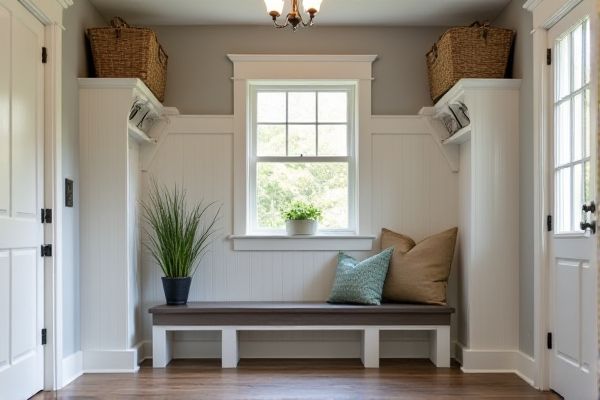
Garage mudrooms offer convenient entry points from your vehicle, reducing dirt tracked into the home, while indoor mudrooms provide a more integrated space with enhanced climate control and design flexibility. Explore the rest of the article to discover which mudroom style best suits your lifestyle and home layout.
Table of Comparison
| Feature | Garage Mudroom | Indoor Mudroom |
|---|---|---|
| Location | Between garage and house entry | Inside the main living area, near entryway |
| Purpose | Transition space for outdoor gear from car to home | Organized entry zone for shoes, coats, and daily use |
| Design Considerations | Durable flooring, moisture-resistant materials | Comfort-focused, aesthetic integration with home decor |
| Common Features | Storage benches, hooks, cubbies, utility sink | Seating, coat racks, shoe storage, art or decor |
| Climate Control | Often unheated or less insulated | Heated and climate-controlled space |
| Space Size | Generally smaller, focused on quick entry | Can be larger, multi-functional |
| Examples | Utility mudroom with direct car access | Stylish entry mudroom with storage and seating |
Introduction to Mudrooms: Purpose and Benefits
Garage mudrooms serve as practical transition spaces between the garage and living areas, offering storage solutions for shoes, coats, and outdoor gear while minimizing dirt and clutter inside the home. Indoor mudrooms, typically located near main entrances, provide organized storage and help maintain cleanliness by containing wet or muddy items before entering living spaces. Both types enhance home functionality by promoting organization, protecting interior flooring, and creating designated zones for outdoor essentials.
What is a Garage Mudroom?
A garage mudroom serves as a transitional space between your garage and home, designed to store shoes, coats, and outdoor gear efficiently. This area often includes durable flooring and built-in storage solutions to manage dirt and clutter brought in from the car. Unlike an indoor mudroom, a garage mudroom prioritizes easy cleaning and direct access to the vehicle.
What Defines an Indoor Mudroom?
An indoor mudroom is a dedicated transition space within the home's interior designed to contain dirt, moisture, and clutter brought in from outside. It typically features durable flooring, built-in storage solutions like cubbies or lockers for shoes and outerwear, and easy-to-clean surfaces to maintain cleanliness throughout the home. Unlike garage mudrooms, indoor mudrooms serve as a buffer zone between the main living areas and the exterior, enhancing organization and reducing debris tracking.
Key Differences Between Garage and Indoor Mudrooms
Garage mudrooms typically serve as transitional spaces between the car and home, featuring durable flooring, storage for outdoor gear, and often include benches for removing shoes. Indoor mudrooms are more integrated into the home's interior, providing organized storage for everyday items and access to main living areas, often with design elements that match the home's decor. Key differences include location, durability requirements, and functional focus, with garage mudrooms emphasizing utility and indoor mudrooms prioritizing seamless integration and aesthetics.
Space Utilization: Garage vs Indoor Mudrooms
Garage mudrooms maximize space by utilizing areas adjacent to vehicle storage, often incorporating vertical storage solutions and durable materials for wet or dirty items. Indoor mudrooms are designed to optimize entryway space with built-in seating, cubbies, and hooks, blending functionality with home aesthetics. Choosing between the two depends on the available square footage and the need to separate outdoor debris from living areas effectively.
Organization and Storage Solutions
Garage mudrooms offer practical organization with durable storage options designed for outdoor gear, such as heavy-duty hooks, benches with cubbies, and waterproof bins, making it easy to manage muddy shoes and sports equipment. Indoor mudrooms provide more refined storage solutions like built-in cabinetry, shelving, and lockers tailored to blend seamlessly with home decor while keeping your daily essentials organized and accessible. Choosing between the two depends on your lifestyle needs, as garage mudrooms excel in handling rougher items, whereas indoor mudrooms prioritize aesthetic appeal and multifunctional storage.
Design and Aesthetic Considerations
Garage mudrooms typically prioritize functionality with durable materials like tile or rubber flooring to handle dirt and moisture, while indoor mudrooms often emphasize style with hardwood or decorative tile to blend seamlessly with home interiors. Your choice depends on aesthetic preferences and practical needs; indoor mudrooms can incorporate built-in storage, seating, and decorative elements that enhance overall home design. Garage mudrooms usually have a more utilitarian design focused on easy cleaning and heavy use, contrasting with the polished appearance of indoor mudrooms.
Durability and Material Choices
Garage mudrooms typically require more durable, moisture-resistant materials like vinyl flooring and metal storage due to higher exposure to dirt and weather elements. Indoor mudrooms can utilize softer, aesthetic materials such as hardwood or tile, prioritizing comfort and style over heavy-duty resilience. Choosing the right material ensures your mudroom withstands daily wear while complementing your home's interior.
Which Mudroom is Best for Your Home?
Garage mudrooms provide a practical transition space for removing shoes and outerwear directly from the vehicle, minimizing dirt tracked into the home and optimizing storage for outdoor gear. Indoor mudrooms offer a more controlled environment insulated from outdoor elements, enhancing temperature regulation and decor integration while maintaining cleanliness. Choosing the best mudroom depends on your home's layout, climate considerations, and daily routines to maximize convenience and functionality.
Conclusion: Choosing Between Garage and Indoor Mudrooms
Choosing between a garage mudroom and an indoor mudroom depends on household needs and available space. Garage mudrooms excel in practicality for entry points linked to vehicles, offering storage for outdoor gear and easy cleanup. Indoor mudrooms provide a more controlled environment with enhanced comfort and design flexibility for organizing daily essentials near main living areas.
 homyna.com
homyna.com